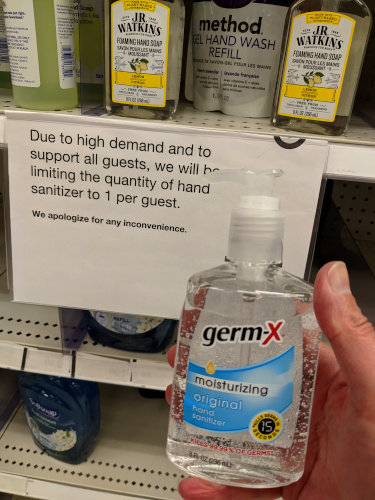
I mean, the idea of marketing canned water as “Liquid Death! (murder your thirst)” is weird enough (IIRC they wanted to make water “cool” like energy drinks), but the “healthy savings” label just kind of makes it!

I mean, the idea of marketing canned water as “Liquid Death! (murder your thirst)” is weird enough (IIRC they wanted to make water “cool” like energy drinks), but the “healthy savings” label just kind of makes it!
Remember last year when it was virtually impossible to get hand sanitizer? You couldn’t order it online, you couldn’t order it for an in-store pickup, and stores that had it were limiting how many of those tiny bottles each customer could buy? Breweries and distilleries were stepping in to supplement the supply, but it still wasn’t enough.
I mean, I don’t like to leave my camera visible in the car when I park, but for a while, I was more worried about leaving a two-ounce bottle of hand sanitizer where it could be seen.
Heck, when I found an 8-ounce bottle at Target in May 2020, I snapped a photo to send it home!

Times have changed.
Factory lines got up to speed after a few months. We bought extra to make sure we wouldn’t run out. Then we learned that Covid spreads more by sharing air than by touching surfaces. And a third of the population convinced themselves it wasn’t a problem, while half to two thirds of the population have gotten at least partly vaccinated against it. And after a year with multiple waves of cases, the rates are currently waaaaaay down in California.
And we’re all so tired of it all.
And we don’t need as much hand sanitizer as we thought we were going to a year ago.
This is the same store this week. Four rolling shelf units and at least one section of the wall shelving. Full.

So, um, anybody want to buy some hand sanitizer?
As soon as I stepped out the door for a walk this morning, I heard a lot of crows making a huge racket down the street. They were perched on a telephone pole, flying up and swooping around like they were trying to scare off a hawk.
Of course I walked toward them to see what was going on.
By the time I reached the end of the block, the crows had given up and flown off. But I noticed people were out in their front yards looking up at a tree. It turns out the crows had been trying to scare off a hawk that had killed a pigeon and settled into the tree to eat it. At first I could only see the occasional feather raining down, until I moved to where I could see through a gap in the branches. Continue reading
Grooming geese: Nature’s panorama fail.
Seriously, though, I was determined to get some decent photos of these two geese because they are unusual. They’re clearly Canada Geese in terms of body shape and the pattern of markings. But every other goose of this type that I’ve seen has had white patches on the sides of the head, not brown patches, and lighter colored wings.
I uploaded the photos to iNaturalist, and since iNat’s AI didn’t have any better suggestions for species, I tagged them with the Branta genus. (Observations: one goose and another goose.) Someone who knows more about geese than I do suggested they might be hybrids, or they might be Canada Geese with a mutation.
I’ll have to keep an eye out for this pair the next time I’m there. I know a lot of the waterfowl use it as a migration stop, but I’m pretty sure some of the ducks and geese live there year-round.
A few Covid-19 rules are still in place at this botanical garden, though it’s a lot more relaxed than it was last spring when they managed to stay open even through the early-pandemic lockdowns.
An Anna’s hummingbird perched at local park. Most of the time they don’t stay in one place long enough for me to even focus on them, never mind catch a photo. Even when they pause somewhere like this one, it’s usually just for a few moments before they fly off again.
Of course, the reason the bird was staying in one spot was that it was grooming itself, so I also had quite a few shots that looked…less impressive.
I finally got around to trying out No Man’s Sky a few weeks ago. I started on a super-hot planet, where you need to find shelter and/or resources to recharge your suit’s hazard protection system to keep cool. Got killed a few times trying to figure out what I was doing. And after about 20 minutes, my computer spontaneously shut itself down.
I waited a few minutes to let it cool down, then tried again. Managed to figure out a bit more of what I needed to do in the game, and then the same thing happened.